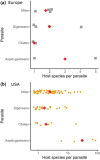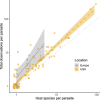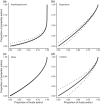Mussel parasite richness and risk of extinction
- PMID: 35929586
- PMCID: PMC10087751
- DOI: 10.1111/cobi.13979
Mussel parasite richness and risk of extinction
Abstract
Parasite conservation is important for the maintenance of ecosystem diversity and function. Conserving parasites relies first on understanding parasite biodiversity and second on estimating the extinction risk to that biodiversity. Although steps have been taken independently in both these areas, previous studies have overwhelmingly focused on helminths in vertebrate hosts over broad scales, providing low resolution and excluding a large proportion of possible host and parasite diversity. We estimated both total obligate parasite richness and parasite extinction risk in freshwater mussels (Unionidae and Margaritiferidae) from Europe and the United States to provide a case study for considering parasite conservation in a severely understudied system. We used currently reported host-parasite relationships to extrapolate parasite diversity to all possible mussel hosts and then used the threat levels of those hosts to estimate the extinction risk for both described and undescribed parasites. An estimated 67% of parasite richness in freshwater mussels is undescribed and over 80% of the most host-specific groups (digenean trematodes and ciliates) are undescribed. We estimated that 21% of this total parasite fauna is at immediate risk of extinction, corresponding to 60 unique species, many of which will likely go extinct before being described. Given the important roles parasites play in community structure and function and the strong ecosystem engineering capacities of freshwater mussels, such extinctions are likely to severely affect freshwater ecosystems. Our detailed study of mussel parasites provides compelling evidence for the hidden conservation threat to parasites through extinction cascades and shows parasites are deserving of immediate attention.
La conservación de parásitos es importante para el mantenimiento de la diversidad y funcionamiento de los ecosistemas. La conservación de parásitos depende en primera instancia del entendimiento de la biodiversidad de parásitos y, en segunda, de la estimación del riesgo de extinción de esa biodiversidad. Mientras que se han tomado medidas en ambas áreas, estudios previos se han enfocado abrumadoramente en helmintos de hospederos vertebrados, proporcionando baja resolución y excluyendo a una amplia proporción de una probable diversidad de hospederos y parásitos. Estimamos tanto la riqueza de parásitos obligados como el riesgo de extinción de mejillones de agua dulce (Unionidae y Margaritiferidae) de Europa y Estados Unidos para proporcionar un caso de estudio para considerar la conservación de parásitos en un sistema severamente poco estudiado. Utilizamos las relaciones hospedero-parásito registradas hasta la fecha para extrapolar la diversidad de parásitos a todas las especies posibles de mejillones hospederos y luego utilizamos los niveles de amenaza de aquellos hospederos para estimar el riesgo de extinción tanto para parásitos descritos y no descritos. Alrededor de 67% de la riqueza de parásitos de mejillones de agua dulce no esta descrito, así como mas de 80% de los grupos específicos de hospederos (trematodos digeneos y ciliados) tampoco están descritos. Estimamos que 21% del total de esta fauna de parásitos está en riesgo inminente de extinción, correspondiendo a 60 especies únicas, muchas de las cuales probablemente se extinguirán antes de ser descritas. Dado la importancia del papel que desempeñan los parásitos en la estructura y función de la comunidad y las notables capacidades de los mejillones de agua dulce para la ingeniería del ecosistema, es muy probable que tales extinciones afecten severamente a los ecosistemas dulceacuícolas. Nuestro estudio detallado de los parásitos de mejillones proporciona evidencia convincente de la amenaza oculta para los parásitos mediante cascadas de extinción y muestra que los parásitos son merecedores de atención inmediata.
Keywords: ciliado; ciliate; coextinción; coextinction; mite; richness; trematode; trematodo; unionid; uniónido; Ácaro.
© 2022 The Authors. Conservation Biology published by Wiley Periodicals LLC on behalf of Society for Conservation Biology.
Figures



Similar articles
-
Host Diversity Affects Parasite Diversity: A Case Study Involving Unionicola spp. Inhabiting Freshwater Mussels.J Parasitol. 2020 Oct 1;106(5):675-678. doi: 10.1645/19-190. J Parasitol. 2020. PMID: 33126252
-
Biodiversity loss decreases parasite diversity: theory and patterns.Philos Trans R Soc Lond B Biol Sci. 2012 Oct 19;367(1604):2814-27. doi: 10.1098/rstb.2012.0110. Philos Trans R Soc Lond B Biol Sci. 2012. PMID: 22966137 Free PMC article. Review.
-
Investigating biodiversity patterns across scales in freshwater mussels.Mol Ecol. 2023 Nov;32(22):5891-5893. doi: 10.1111/mec.17181. Epub 2023 Nov 2. Mol Ecol. 2023. PMID: 37915309
-
Lake-stream transition zones support hotspots of freshwater ecosystem services: Evidence from a 35-year study on unionid mussels.Sci Total Environ. 2021 Jun 20;774:145114. doi: 10.1016/j.scitotenv.2021.145114. Epub 2021 Feb 6. Sci Total Environ. 2021. PMID: 33607437
-
An interdisciplinary approach to improving conservation outcomes for parasites.Conserv Biol. 2025 Feb;39(1):e14431. doi: 10.1111/cobi.14431. Epub 2025 Jan 19. Conserv Biol. 2025. PMID: 39827902 Free PMC article. Review.
Cited by
-
Conservation of parasites: A primer.Int J Parasitol Parasites Wildl. 2023 Jul 3;21:255-263. doi: 10.1016/j.ijppaw.2023.07.001. eCollection 2023 Aug. Int J Parasitol Parasites Wildl. 2023. PMID: 37483309 Free PMC article.
References
-
- Alves, P. V. , Vieira, F. M. , Santos, C. P. , Scholz, T. , & Luque, J. L. (2015). A checklist of the aspidogastrea (Platyhelminthes: Trematoda) of the world. Zootaxa, 3918, 339–396. - PubMed
-
- Balvanera, P. , Daily, G. C. , Ehrlich, P. R. , Ricketts, T. H. , Bailey, S. A. , Kark, S. , & Pereira, H. (2001). Conserving biodiversity and ecosystem services. Science, 291, 2047. - PubMed
-
- Blasco‐Costa, I. , & Poulin, R. (2017). Parasite life‐cycle studies: A plea to resurrect an old parasitological tradition. Journal of Helminthology, 91, 647–656. - PubMed
-
- Bolotov, I. N. , Klass, A. L. , Kondakov, A. V. , Vikhrev, I. V. , Bespalaya, Y. V. , Gofarov, M. Y. , Filippov, B. Y. , Bogan, A. E. , Lopes‐Lima, M. , Lunn, Z. , Chan, N. , Aksenova, O. V. , Dvoryankin, G. A. , Chapurina, Y. E. , Kim, S. K. , Kolosova, Y. S. , Konopleva, E. S. , Lee, J. H. , Makhrov, A. A. , … Vinarski, M. V. (2019). Freshwater mussels house a diverse mussel‐associated leech assemblage. Scientific Reports, 9, 1–22. - PMC - PubMed
Publication types
MeSH terms
LinkOut - more resources
Full Text Sources

